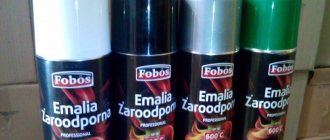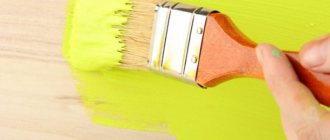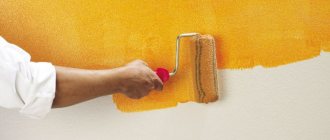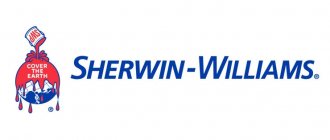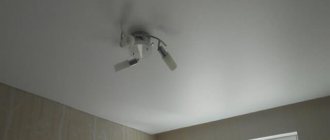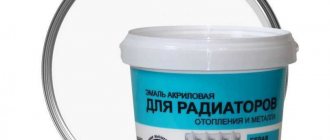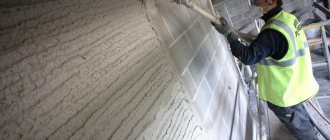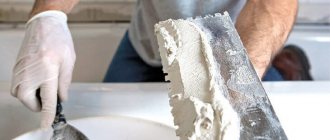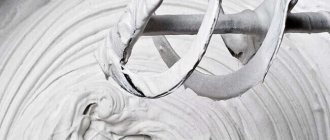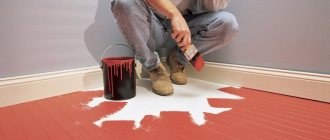Features of water-based paints
In addition to the unpleasant pungent odor, which is completely absent, such paints and varnishes are universal and environmentally friendly, suitable for treating any surface, both indoors and outdoors.
There is no need to leave the premises during cosmetic repairs. You can continue to do other things while the painted surface dries.
There is no pungent odor that is toxic and harmful to health, which cannot but please the person who started the renovation and does not want to rent temporary housing or live on the side during the process.
Types of water-dispersion coating
Water-dispersed paints are distinguished by the type of polymer, which is responsible for the formation of a film during the drying process. According to this criterion, the division is into 3 categories.
The first of them includes polyvinyl acetate dispersion. This composition has a rich color, but is used only in dry rooms due to its low resistance to moisture.
The second type is represented by butadiene styrene dispersion. It is distinguished by high moisture resistance and relatively low price. But it is not applicable for exterior decoration, since it tends to turn yellow when exposed to the sun and crack in the cold.
The most expensive type of water-dispersed paint is acrylic. It is considered the most resistant to all negative influences, which gives it universal status.
Before choosing one of the types of coating, it is worth deciding on the features of the upcoming work:
- temperature;
- humidity;
- type of lighting.
Depending on the specific conditions, the choice is made in favor of one or another type of paint.
What can be painted
In the process of cosmetic work, you can treat any surface, both inside and outside:
- Made of concrete;
- Brick;
- Stone;
- Metal;
- Wood;
- Plastic;
- Apply to any plastered surface.
Painting with water-dispersion paint is an easy process, accessible even to a novice builder; it will not cause any problems if he does not have specific skills for working with paints and varnishes.
Description of water-acrylic compositions
Such paints have a consumption of 150 g per square meter. The minimum value reaches 120 g per m2. This figure depends on the properties of the material being processed, which can be rough or smooth. The consumption will be higher if the surface has high absorbency.
Some types of water-based acrylic paints are applied in a volume of 200 g per square meter to increase wear resistance. The operational mechanical characteristics of such coatings are regulated by GOST 28196-89. The proportion of non-volatile substances, which include auxiliary components and resins, reaches 57% by weight of the paint. The pH level can be almost zero or reach 9.5, which indicates a slightly alkaline composition.
Among the features of water-based acrylic paints are:
- durability of the coating;
- color brightness;
- low setting time;
- no unpleasant odor.
The next layer can be applied within an hour after the previous one. As for the brightness of the color, it does not disappear even under the influence of ultraviolet radiation. If you want to purchase acrylic-based water-based interior paint, you should know not only about its characteristics, but also about the cost. The minimum price is 150 rubles. per liter, and the maximum is 1000 rubles. per liter The price is influenced by brand awareness and performance properties. The most expensive are the compositions that have high color saturation and durability.
Advantages
In addition to versatility in use and environmental friendliness (which is especially important for children's rooms), water-dispersion paints have significant advantages that set them apart from other paintwork materials:
- Dries quickly;
- There are no difficulties with application;
- Available in one color – white. This makes it convenient to do tinting and select the desired shades;
- Surfaces can be easily repainted after application. This kind of paint does not need to be scraped off for a long time and intensively;
- The tool and hands can be easily washed after use;
- Good adhesion (adhesion, stickiness to the surface);
- The coating is durable.
Among the disadvantages, it can be noted that not all types of water-based paints, which are offered in numerous photo catalogs, are not suitable for damp, damp rooms. And in the process of purchasing them, you need to carefully read the specification and scope of application.
Latex paint
This type of paint is great for covering surfaces in the bathroom and kitchen, as its composition is superior to acrylic paints and has a water-repellent effect.
The surface that you will cover with latex paint does not have to be perfect; all imperfections can be hidden by covering the surface with two layers of paint. It takes two hours for the paint to dry completely.
Silicone paint
The most expensive paint option, which includes the qualities of the two above. The consistency of the paint is very elastic and can hide minor surface imperfections. The paint allows steam to pass through, making it more unique.
The paint is suitable for covering various types and structures. It can be applied over old paint. It will cover the color well without bald spots.
Silicate paint
One of the cheapest types of paint. It is excellent for working on building facades; for 20 years it does not lose its appearance and withstands weather conditions such as hail, rain, snow and sun.
This effect is achieved due to the composition which contains dye, fiberglass elements and water emulsion.
The paint is not suitable for indoor use.
Mineral paint
The type of paint is ideal for working around the house. The composition includes lime and concrete. It can be used to cover brick, concrete and plaster. After drying, a film forms on the paint, which makes it waterproof.
Aerosol paints
The most convenient type of paint to use. Water-based spray paints are popular these days. You need to spray them over the surface several times. For rich color and a smooth surface, 3 layers are enough.
If you need to remove paint from the surface, this can be done with a damp cloth, but within 30 minutes after application.
Stamp ink
Stamp inks are made from alcohol and oil. Water is no exception; water-based stamp inks penetrate the paper perfectly without destroying it.
- The safe ink composition does not destroy the surface of the paper and stamp.
- A wide variety of bright stamp inks are available for sale.
Flexopaint
Paint containing acrylic, intended for photo printing.
Classification
The characteristics of water-based paints are affected by their composition. The scope of their application depends on the components included in them.
Various color shades can be achieved using separate tints, which are purchased separately.
Leafing through the catalog, you can see that the most common types of the best water-based paints are:
- Acrylic;
- Mineral;
- Silicone;
- Latex;
- Silicate.
When choosing paint for wood, you need to pay attention to acrylic enamel, which has antiseptic properties that prevent the appearance of moss and mold on the surface.
Painting
Preparation
Water-based paints, like any other paint and varnish coatings, must be applied to a prepared base.
Therefore, before painting, you should perform the following steps:
- First of all, the surface is cleaned of old paintwork.
- Then the base must be cleaned of dust and dirt. If we are talking about a metal surface, then it is necessary to remove traces of corrosion.
- Next, the surface is covered with a layer of primer, which improves adhesion, strengthens loose surfaces, and also gives the base other properties (antiseptic, anti-corrosion, etc.)
- If necessary, the surface is puttyed, for example, if walls are being prepared for painting. (See also the article How to putty walls: features.)
- After this, the surface is sanded with fine sandpaper.
- To complete the work, another layer of soil must be applied to the base.
Paint tinting
Applying paint
Once the surface is ready, you can begin applying paint. For these purposes, use brushes, rollers or a spray.
The instructions look like this:
- First of all, if necessary, the composition is tinted. To do this, pour the material into a small container and gradually add paint colors until the desired color is obtained. After the proportions are known, the rest of the paint should be mixed with the color.
- Regardless of which tool is used, the coating is applied in an even, thin layer, without drips or spattering.
- After the first layer of coating has dried, the procedure must be repeated again. As a rule, to obtain a high-quality result, applying two layers is sufficient.
Painting walls with a roller
Advice! If the paint has thickened, you can add water to it, but not more than 10 - 15 percent.
This completes the painting process. Thanks to the rapid drying of the composition, the painted surface can be used within a few hours after application.
Surface preparation
Like any paint, water-dispersion paint is also applied to a previously prepared surface. It should be taken into account that the coating must be perfectly smooth.
Some paints, such as acrylic ones, can highlight all the defects of the treated walls. Therefore, the preparation process must be approached with special responsibility.
Before applying the first coat of paint, you need to do the following:
- Clean the surface from old paint, rust, dirt;
- Apply primer. This will give the surface anti-corrosion and antiseptic properties and increase adhesion;
- Putty;
- Polish;
- Apply a final coat of primer;
- Dilute the paint according to the instructions to the desired thickness;
- Add the desired color.
Laying tiles on a surface painted with water-based paint
Any paint is a poor base for laying tiles. If the wall is covered with water-based paint, then the process of removing it will be long and laborious. You can lay tiles on top of paint, while observing some requirements:
Make notches all over the painted surface by scraping off the paint with a chisel or hard spatula. The surface will become rough and the tile adhesive will be able to adhere firmly to the wall. The surface can be cleaned of debris and grease using an alcohol solution or acetone. To prime a painted wall, choose a deep penetration primer, then the adhesion of the materials will be higher.
REFERENCE It is better to prime the marks made with a brush, then the liquid will more accurately fall on the prepared area.
If the painted surface is also puttied, then in this case it is necessary to remove the putty. At least 70%. Otherwise, when laying the tiles, the gypsum putty will become saturated with moisture and fall off.
If cement facade putty was used, then gluing tiles onto it is possible, but not advisable. It turns out that the glued tiles will not stick to the wall, but to a spacer in the form of cement putty. The probability of the tiles rebounding in this case is higher.
Which manufacturer to choose
Knowing the popular paint brands will help you choose quality products. So you can note the compositions, there are many products on sale, usually there are alkyd types of paints that are of high quality.
The paints are of high quality.
The use of paints is also popular, many people know it, because these products have been on the market for a long time and are considered to be of high quality. Different types of white paint are produced.
These products have been on the market for a long time and are considered to be of high quality.
Among the Russian brands, one can highlight “Yaroslavl Paints”, which are also of high quality and are not so expensive. At the same time, the brand produces different types of white paints; you should choose based on the type of base that will be painted.
The brand produces different types of white paints.
r apartments. It is important to think in advance which shade of white is best suited for a particular room, and then select the appropriate paint composition. There are a large number of similar products on the market; choosing the appropriate option based on price and quality will not be difficult.
Briefly about the main thing
You can independently finish walls with water-based paint if you follow known rules and developed technologies. Important emphasis is placed on the choice of tools. It is necessary to calculate the area of the walls to determine the amount of material. Color and tinting can be selected at retail outlets on the computer. However, you can do this yourself manually. It should be remembered that the tone changes as the paint dries.
High-quality preparation of the surface to be painted is 50% success. To avoid streaks and gaps, the work is carried out in stages in several layers. Each new layer is applied only after the previous one has dried. Speed of work is also important due to the rapid setting of materials.
If all conditions are met, a good result is guaranteed.
Ratings 0
Procedure for working with water-dispersed paints
To work with the coating, you can use a brush or roller. It is better to purchase a roller with a long handle in order to reach all surface levels. The wall in the room must be leveled and primed so that the layers lay correctly.
Paint needed:
- Dilute;
- Add pigment to it;
- Stir thoroughly.
Work should start from the window. The layer is placed both along and across the surface to fill the space evenly. The coating can consist of 1-3 layers. The interval between paintings is 3-4 hours. Approximately 140-180 g of paint is required for 1 m2 of flat surface.
Application Features
Knowing some secrets will help you paint walls with water-based paint yourself:
- When preparing the composition, you need to immediately calculate the amount that will be sufficient for the entire room. Otherwise, finding the same shade will not be easy
- The walls are painted in one go. This is the main condition for quality finishing.
- To paint corners and small details you will need a small brush, no more than 5 cm wide.
- Excess paint is immediately wiped off on the edge of the pallet, otherwise it will leave streaks on the walls.
- The mixture is applied to small areas from top to bottom.
- Before starting work, the baseboards, window sills, and ceiling (if it is already painted) are insulated with masking tape. Masking tape is also used to mark boundaries. It is removed immediately after painting the area. Once the paint has hardened on the tape, it is almost impossible to remove it without damaging the wall.
To get a good result, you need to have a creative approach to the process, correctly distribute your forces and show imagination.
Composition selection criteria
White paint has several shades, and in order to determine the option that is suitable for a particular interior, you should take into account the chosen design style, as well as how many windows there are in the room and their location. If the windows face north, then you can paint the surface in two colors, the lower zone will have a darker, cold color, the upper zone will be lighter and warmer. For a sunny room, it is permissible to use a snow-white coating with a gray tint.
The layer can have a matte or glossy effect. This way, the matte finish will dim the light and small imperfections won't stand out too much, but it will be difficult to clean.
If dirt appears on such a coating, it is easier to paint it over than to clean it. Glossy paint is easy to clean, but the gloss is cooler. You can paint it in a semi-matte color.
Experts recommend combining painting with white in different tones; an example is the combination of white paint with a gray tint and yellow. This solution will help you get a coating that will look perfectly white. But do not forget that a similar color will appear in daylight; artificial lighting will change the shade in different areas.
Experts recommend combining painting with white in different tones; an example is the combination of white paint with a gray tint and yellow.
What to do if acrylic paint has dried out?
It happens that due to improper storage at home, even in a short time, the composition manages to thicken or dry out greatly. To correct this situation, you must do the following:
- The acrylic mixture differs from simple enamels in that it can be diluted at different degrees of drying of the base composition. So, when the viscosity increases, water is simply added to the solution and mixed well. The main thing is to close the container tightly. This rule also applies to cases where there is a small residue after painting.
- If clots are observed in the composition, then add a little alcohol to the water. The mixture is thoroughly mixed until the lumps completely disappear. A small amount of solvent is poured on top and the container is well sealed.
It is more difficult to restore a dried composition. To do this, a whole set of actions is performed:
- The hardened material is removed from the container and broken into small pieces. It is important to prevent the entry of dirt and dust.
- Lumps must be crushed as much as possible. To do this, you can use a piece of pipe or fittings of suitable diameter.
- The resulting powder is poured into a convenient container and filled with well-heated water. The solution is not stirred, but shaken several times. After a minute, the liquid is drained.
- A new portion of hot liquid is added and the procedure is repeated.
- A special diluent is poured in and the mixture is stirred well until the desired viscosity is obtained. But such a material will no longer have all the properties.
If the paint has dried to a stone state, then it is better not to restore it. Although you can follow the previous procedure, which will require effort and time, the resulting composition is best used for utility rooms.
Using paints in everyday life allows you not only to protect the surface of the material, but also to create a unique design. The modern market offers several types of such solutions, which differ in composition and technical properties.
An important factor when choosing paint is its safety for humans. It is this feature that acrylic composition has, which is very popular.
